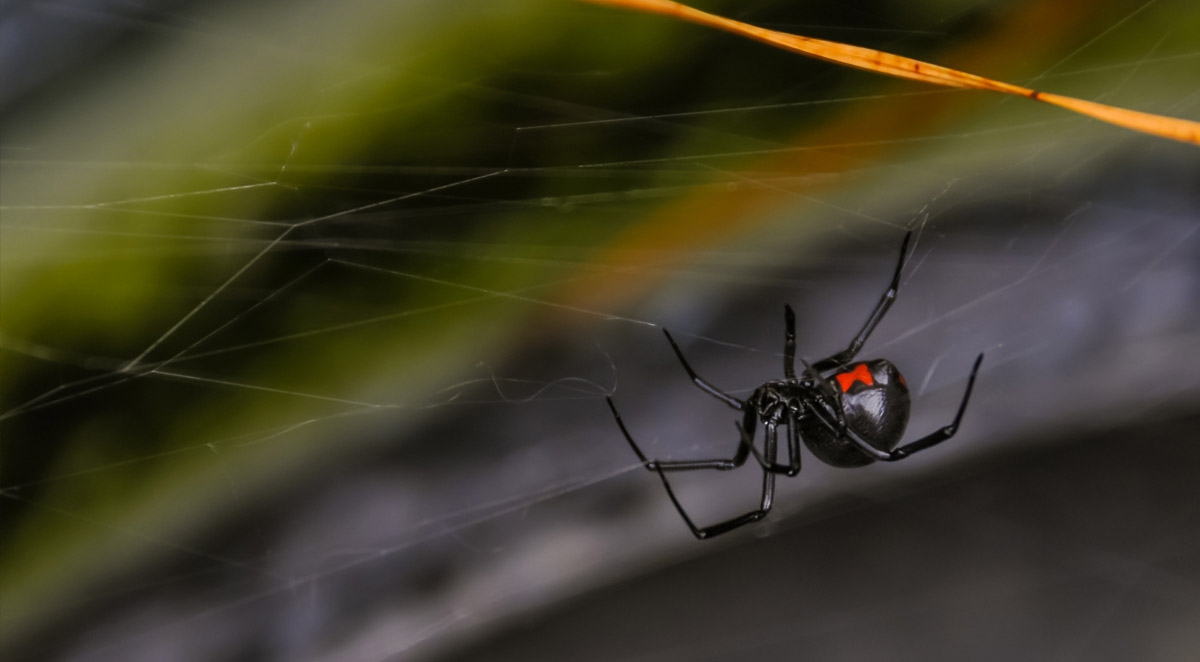At Rid-A-Bug, we've been helping homeowners with effective spider control and spider removal since 1972. We understand that while spiders play an important role in our ecosystem, most people prefer to keep them outside where they belong. This comprehensive guide will help you identify common house spiders, understand their behavior, and implement both natural spider control methods and professional solutions to keep your home spider-free.
Common House Spiders in the Carolinas and Virginia
Before implementing spider prevention measures, it's helpful to know which spiders you're likely to encounter in your home. The following species are commonly found in homes throughout our service area:
American House Spider
The American house spider is perhaps the most common indoor spider species:
- Light brown to beige with darker speckles
- About 1/4 inch body length
- Creates cobwebs in corners and undisturbed areas
- Generally harmless to humans
- Often found in basements, attics, and less-trafficked areas
Wolf Spiders
These ground-dwelling hunters are often mistaken for more dangerous species:
- Dark brown with striped patterns
- Larger bodies, ranging from 1/2 to 2 inches
- Fast-moving and don't build webs
- Excellent eyesight for hunting
- Usually enter homes through gaps in doors or windows
- Despite their intimidating appearance, their bite is rarely serious
Jumping Spiders
These small but distinctive spiders:
- Compact bodies with distinct "faces"
- Range from 1/8 to 3/4 inch
- Jump impressive distances relative to their size
- Excellent vision
- Often found on windows, walls, and outdoor siding
- Generally harmless to humans
Cellar Spiders (Daddy Long-Legs)
These long-legged spiders:
- Extremely long, thin legs with small bodies
- Pale yellow to light brown coloration
- Create loose, irregular webs in corners
- Often found in basements, crawl spaces, and garages
- Completely harmless to humans
Black Widow
While less common indoors, black widows can occasionally enter homes:
- Shiny black with distinctive red hourglass on underside
- Build irregular webs in dark, undisturbed areas
- Prefer woodpiles, cluttered areas, or storage spaces
- Venom is potentially dangerous, especially to children and elderly
- Not aggressive but will bite if threatened
Brown Recluse
Though less common in our region than many believe, brown recluse spiders:
- Light to medium brown with violin-shaped marking on back
- Six eyes arranged in pairs (most spiders have eight eyes)
- Prefer dark, undisturbed areas
- Can deliver a bite that requires medical attention
- Primarily found in undisturbed storage areas
Why Spiders Enter Your Home
Understanding what attracts spiders to your home is crucial for effective spider prevention. Spiders typically enter houses for three main reasons:
1. Food Sources
Spiders primarily feed on insects, so an abundance of other pests in your home creates an attractive hunting ground. Common spider prey includes:
- Flies
- Mosquitoes
- Ants
- Moths
- Roaches
- Silverfish
2. Shelter and Environment
Spiders seek environments that offer:
- Protection from predators
- Stable temperatures
- Dark, undisturbed corners
- Humid conditions (for many species)
- Safe places to build webs or hunt
3. Breeding Opportunities
Some spiders enter homes specifically to:
- Find mates
- Establish egg sacs in protected areas
- Create nursery webs for spiderlings
- Seek better conditions for offspring survival
Signs of Spider Infestation
Knowing the signs of spider activity can help you address the issue before it becomes a full-blown infestation:
- Visible webs in corners, ceiling junctions, or around windows
- Egg sacs - small silk-wrapped bundles often attached to webs
- Spider droppings - small dark spots beneath webs or along walls
- Cast skins from molting
- Live spider sightings, particularly repeated sightings of the same species
- Unexplained insect decline indoors (potentially being caught by spiders)
- Web remnants on furniture or in corners
Effective Spider Prevention Methods
Preventing spiders from entering your home is always preferable to dealing with an established infestation. Here are comprehensive prevention strategies:
Seal Entry Points
Spiders can squeeze through remarkably small openings:
- Inspect and caulk cracks around window frames and door frames
- Install weatherstripping under exterior doors
- Repair torn window and door screens
- Seal gaps around utility penetrations (pipes, vents, cables)
- Cover vents with fine mesh screening
- Check for gaps in your home's foundation and seal appropriately
Reduce Exterior Attractants
Making your home's exterior less appealing to spiders:
- Trim vegetation away from your home's foundation and walls
- Keep bushes and tree limbs trimmed back from the house
- Remove leaf litter and debris from around the foundation
- Position outdoor lighting away from doors and windows (insects attracted to lights will attract spiders)
- Replace white exterior lights with yellow sodium vapor lights (less attractive to insects)
Indoor Housekeeping Practices
Regular cleaning disrupts spider habitats and removes their food sources:
- Vacuum thoroughly and regularly, including corners, baseboards, and under furniture
- Dust high areas where webs form, including ceiling corners and light fixtures
- Reduce clutter in storage areas, basements, and garages
- Store items in sealed plastic containers rather than cardboard boxes
- Keep firewood outdoors until ready to use
- Clean up food crumbs and spills promptly to avoid attracting insects
Natural Spider Control Methods
For those who prefer eco-friendly approaches, several natural spider control methods can be effective:
Essential Oils
Certain scents repel spiders naturally:
- Peppermint oil: Mix 15-20 drops with water in a spray bottle and apply around windows, doors, and corners
- Tea tree oil: Similar application as peppermint oil
- Eucalyptus oil: Effective when applied to potential entry points
- Citrus oils: Lemon or orange oils can deter spiders
- Lavender: Both the plant and oil form can repel spiders
Vinegar Solutions
White vinegar's acidity deters spiders:
- Mix equal parts white vinegar and water
- Spray directly on spiders to eliminate them
- Apply to entry points and known spider pathways
- Reapply weekly for best results
Diatomaceous Earth
This natural powder consists of fossilized aquatic organisms:
- Sprinkle in areas where spiders travel
- Apply behind appliances and in corners
- Safe for humans and pets but dehydrates spiders and insects
- Use food-grade diatomaceous earth for indoor application
Natural Predators
Encourage spider predators around your property:
- Birds (install birdhouses and feeders away from the house)
- Lizards (in warmer climate areas)
- Certain wasps that prey on spiders
Spider-Repelling Plants

Growing certain plants around your home can help deter spiders:
- Lavender
- Mint
- Eucalyptus
- Citronella
- Lemon balm
- Rosemary
Read our blog post about the pros and cons of eco-friendly pest control.
Integrated Pest Management for Spider Control
At Rid-A-Bug, we implement Integrated Pest Management (IPM) practices for effective and environmentally responsible spider control:
Inspection and Identification
Professional spider control begins with:
- Thorough inspection of the property
- Correct identification of spider species
- Locating entry points and harborage areas
- Identifying factors contributing to infestations
Habitat Modification
Changing conditions to make your home less hospitable to spiders:
- Recommending specific exclusion measures
- Addressing moisture issues that attract prey insects
- Suggesting landscape modifications
- Recommending storage practices that discourage spiders
Targeted Treatments
When treatments are necessary, we focus on:
- Precise application to minimize environmental impact
- Using the least toxic effective options
- Treating only where needed rather than broadcast spraying
- Focusing on entry points and typical harborage areas
Follow-up and Monitoring
Effective spider control includes:
- Regular monitoring for new activity
- Adjusting treatment strategies as needed
- Ongoing prevention recommendations
- Seasonal approaches as spider activity changes
Read our blog post about why people are afraid of spiders.
When to Call a Professional
While many spider situations can be handled with DIY methods, certain circumstances warrant professional spider removal:
- Identification of dangerous species like black widows or brown recluse
- Persistent infestations despite home treatment efforts
- Large-scale infestations affecting multiple areas of the home
- Spiders in sensitive areas like children's rooms or near beds
- Allergic individuals in the household
- Preventative treatment before spider season
Spider Control in Advance, NC
Residents of Advance, North Carolina, face unique spider challenges due to the area's climate and environment. The combination of wooded areas, suburban development, and varying seasonal temperatures creates ideal conditions for several spider species.
Common spider species in Advance include the American house spider, wolf spiders, and jumping spiders, with occasional black widow sightings, particularly in outbuildings and garages. The abundant insect population in this region also provides ample food sources for spiders.
Rid-A-Bug provides specialized spider control services for Advance residents, including:
- Customized treatment plans based on local spider species
- Preventative perimeter treatments
- Seasonal approaches addressing changing spider activity patterns
- Follow-up monitoring and maintenance programs
Our technicians understand the specific environmental factors affecting Advance homes and develop targeted strategies to address these unique challenges.
Seasonal Spider Control Tips
Spider activity varies throughout the year, requiring different approaches:
Spring
- Conduct thorough spring cleaning to disrupt overwintering spiders
- Seal entry points revealed by winter damage
- Remove egg sacs before they hatch
- Establish preventative treatments before peak activity
Summer
- Monitor and treat outdoor areas to prevent migration indoors
- Pay special attention to windows and doors that are opened frequently
- Address increased insect activity that attracts hunting spiders
- Check outdoor lighting that may be drawing insects (and consequently, spiders)
Fall
- Increase vigilance as spiders seek winter shelter
- Check items brought in from storage
- Inspect firewood before bringing it indoors
- Apply preventative treatments around entry points
Winter
- Monitor indoor heated areas where spiders remain active
- Check storage areas and boxes
- Vacuum and clean undisturbed areas
- Prepare prevention plans for spring emergence
FAQ About Spider Control
-
Are most house spiders dangerous?
No, the vast majority of house spiders in North Carolina, South Carolina, and Virginia are harmless to humans. Of the hundreds of spider species in our region, only black widows and brown recluse spiders pose significant health risks, and they rarely bite unless directly threatened.
-
How long do house spiders live?
The lifespan varies by species, but most common house spiders live between one and two years. Some species, particularly female spiders, can live significantly longer if conditions are favorable.
-
Do spider repellents really work?
Natural repellents like essential oils can be effective temporary deterrents but typically require frequent reapplication. Commercial repellents vary in effectiveness depending on the ingredients and application method. The most effective approach combines repellents with exclusion methods and habitat modification.
-
Should I kill every spider I see?
Ecologically speaking, spiders provide beneficial pest control by consuming insects. When possible, capturing and releasing outdoor spiders is environmentally preferable. However, potentially dangerous species or infestations may require elimination for safety reasons.
-
How do I keep spiders out of my basement?
Basements require special attention for spider control:
- Reduce humidity with dehumidifiers
- Eliminate clutter and use plastic storage containers
- Seal cracks in the foundation and around pipes
- Vacuum regularly, especially corners and undisturbed areas
- Consider periodic professional treatments for persistent issues
Conclusion
While spiders have their place in nature's balance, most of us prefer they stay outside rather than taking up residence in our homes. With the right combination of prevention, natural control methods, and professional assistance when needed, you can effectively send those scary spiders back to the haunted house where they belong.
For residents in Advance, NC and throughout our service area, Rid-A-Bug offers comprehensive spider control solutions that respect both your safety concerns and environmental considerations. Our experienced technicians can help identify potential issues, implement effective treatments, and provide ongoing prevention strategies.
If spiders have made themselves too comfortable in your home, contact Rid-A-Bug to schedule an inspection. With over 50 years of experience serving the region, our family-owned business is committed to providing fast, dependable, and effective pest management to keep your home spider-free.

